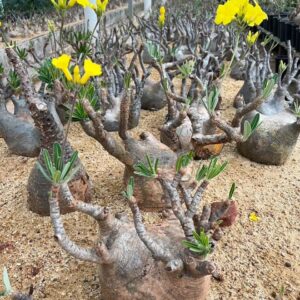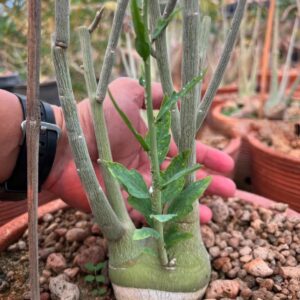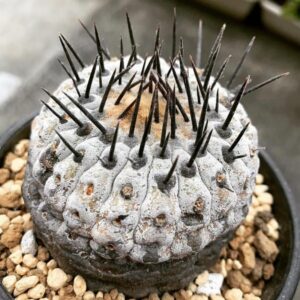zz plant(House plants) online near me
The ZZ plant, scientifically known as Zamioculcas zamiifolia, is a popular and low-maintenance houseplant. Here are some key facts and care tips for ZZ plants:
-
: Native to eastern Africa, including countries like Kenya, Tanzania, and Zimbabwe.
-
: ZZ plant, Zanzibar gem, eternity plant, aroid palm, Zuzu plant.
-
: Features glossy, dark green leaves on upright stems, giving it a sculptural look.
-
: Slow-growing, reaching heights of 2 to 4 feet.
-
: Thrives in low to bright indirect light. Avoid direct sunlight to prevent leaf scorching.
-
: Water sparingly, allowing the soil to dry completely between waterings. Overwatering can lead to root rot.
-
: Use well-draining potting soil, such as a mix designed for succulents.
-
: Prefers temperatures between 65-75°F and can tolerate average to dry humidity.
-
: Feed lightly with a balanced fertilizer once or twice a year during the growing season.
-
: Remove yellow or dead leaves to maintain appearance.
-
: Repot every 2-3 years or when the plant outgrows its container.
-
: Known for purifying the air by removing toxins like xylene, toluene, and benzene.
-
: Stores water in its rhizomes, making it highly drought-tolerant.
-
: All parts are toxic if ingested, so keep away from children and pets.
-
: Divide rhizomes into clumps with at least one leaf stalk and replant in fresh soil.
-
: Take leaf cuttings with a bit of stem and plant in moist soil
How often should I water a ZZ plant
You should water a ZZ plant every 1-2 weeks under normal conditions, allowing the top inch or two of soil to dry out completely between waterings. During winter or in low-light conditions, reduce watering to every 2-3 weeks as the plant enters dormancy and requires less moisture. In summer or brighter light, you may need to water more frequently, but always ensure the soil is dry before watering again to prevent overwatering and root rot
What type of soil is best for a ZZ plant
The best soil for a ZZ plant is a well-draining mix that prevents waterlogging while retaining some moisture. Ideal options include:
-
: These mixes drain quickly, which suits the ZZ plant’s drought-tolerant nature3.
-
: Combine 60% regular potting soil with 40% cactus mix, adding components like perlite, coarse sand, or pumice to improve drainage.
-
: The soil should be neutral to slightly acidic, with a pH of 6.0–7.0.
This type of soil ensures the ZZ plant’s rhizomes remain healthy and free from root rot.
What are the best organic components to include in a ZZ plant soil mix
The best organic components to include in a ZZ plant soil mix are:
-
Compost: Provides essential nutrients and promotes healthy microbial activity, enriching the soil for sustained growth.
-
Peat Moss: Retains moisture while maintaining aeration, ensuring the plant stays hydrated without becoming waterlogged.
-
Coconut Coir: An eco-friendly alternative to peat moss that retains moisture and improves soil structure.
-
Bark (e.g., orchid bark): Adds texture and helps retain moisture while preventing compaction.
-
Worm Castings: Acts as a natural fertilizer, boosting nutrient levels and supporting root health.
These organic materials enhance moisture retention and nutrient availability while balancing the drainage provided by inorganic components like perlite or sand.
What are the benefits of using peat-free potting mixes for ZZ plants
Using peat-free potting mixes for ZZ plants offers several benefits, both for the plant’s health and the environment:
Environmental Benefits
-
Sustainability: Peat-free mixes help conserve peatlands, which are vital ecosystems for carbon storage and biodiversity. Reducing peat use lowers greenhouse gas emissions and supports climate change mitigation efforts.
-
Eco-Friendly Ingredients: These mixes often include renewable materials like coconut coir, bark, and wood fibers, which are more sustainable alternatives to peat.
Plant Health Benefits
-
Improved Drainage: Peat-free mixes typically have excellent drainage properties, reducing the risk of overwatering and root rot—a common issue for ZZ plants.
-
Moisture Retention: Despite their good drainage, many peat-free blends retain adequate moisture, ensuring that ZZ plants stay hydrated without becoming waterlogged.
-
Reduced Pests: Peat-free soils are less likely to attract fungus gnats, a common pest associated with peat-based mixes.
Practical Considerations
-
Nutrient Management: Peat-free mixes are biologically active but may require regular fertilization to replenish nutrients as they can deplete faster than peat-based soils.
-
Adapted Care: These mixes may dry out faster on the surface but retain moisture below. Adjust watering habits by checking soil moisture at root level.
By switching to peat-free potting mixes, you not only provide a healthy growing medium for your ZZ plant but also contribute to a more sustainable gardening practice.
What are the environmental benefits of using peat-free potting mixes for houseplants
Using peat-free potting mixes for houseplants offers significant environmental benefits:
1. Conservation of Peatlands
Peatlands are critical ecosystems that store vast amounts of carbon and support biodiversity. Peat extraction for gardening degrades these ecosystems, releasing stored carbon and contributing to climate change. By using peat-free mixes, gardeners help preserve these vital habitats14.
2. Reduction in Greenhouse Gas Emissions
Peat harvesting releases carbon dioxide and methane, potent greenhouse gases. Switching to peat-free alternatives reduces these emissions, helping combat climate change. For example, peat degradation in England alone releases 11 million tonnes of greenhouse gases annually—equivalent to three coal-fired power plants.
3. Sustainable Water Management
Peatlands play a role in water storage and purification, supplying drinking water and preventing flooding. Protecting these ecosystems by avoiding peat use ensures their continued function in sustainable water management.
4. Promotion of Renewable Resources
Peat-free mixes often incorporate renewable materials like coir, bark, wood fibers, and composted green waste. These alternatives are more sustainable and reduce dependency on non-renewable peat resources.
5. Support for Eco-Friendly Gardening Practices
Peat-free gardening aligns with broader environmental goals, such as reducing carbon footprints and encouraging the use of locally sourced or recycled materials. It fosters a more sustainable approach to plant care while maintaining soil health.
Switching to peat-free potting mixes is a practical step toward greener gardening, benefiting both the planet and future generations.
How do I care for a ZZ plant after receiving it online
Caring for a ZZ plant after receiving it online involves a few simple steps to ensure it thrives in its new environment:
1. Inspect the Plant
-
Check for Damage: Inspect the plant for any signs of damage during shipping, such as bruised or broken leaves.
-
Remove Packaging: Gently remove any packaging materials, taking care not to disturb the roots.
2. Provide Proper Lighting
-
Light Conditions: Place the ZZ plant in a spot with medium to bright indirect light. Avoid direct sunlight, which can cause leaf scorching.
-
Adjustment Period: Allow the plant a few days to adjust to new light conditions.
3. Watering
-
Initial Watering: If the soil feels dry upon arrival, water the plant thoroughly, ensuring excess water drains out of the pot.
-
Future Watering: Water every 1-2 weeks, allowing the top inch or two of soil to dry out completely between waterings.
4. Soil and Repotting
-
Check Soil Moisture: If the soil seems overly dry or wet, adjust your watering schedule accordingly.
-
Repotting: If the plant is pot-bound or the soil seems depleted, consider repotting into a well-draining mix like cactus or succulent soil every 2-3 years.
5. Temperature and Humidity
-
Temperature Range: Keep the plant in temperatures between 65°F-75°F (18°C-24°C).
-
Humidity: Average indoor humidity is suitable for ZZ plants.
6. Fertilization
-
Optional Fertilization: Feed lightly with a balanced fertilizer once or twice a year during the growing season if desired.
7. Pruning and Cleaning
-
Prune Dead Leaves: Remove any yellow or dead leaves to maintain appearance and prevent pests.
-
Clean Leaves: Use a damp cloth to gently wipe leaves and prevent dust buildup.
By following these steps, you can help your ZZ plant adjust well to its new environment and thrive over time.
How can I tell if my ZZ plant is getting too much water
You can tell if your ZZ plant is getting too much water by observing the following signs:
1. Yellowing Leaves
-
Overwatering often causes the leaves to turn yellow. This is due to excess moisture preventing proper nutrient uptake.
2. Mushy or Browning Stems
-
Stems may become mushy or brown, indicating that the roots are waterlogged and beginning to rot.
3. Wet or Soggy Soil
-
Constantly wet soil is a clear sign of overwatering. ZZ plants prefer their soil to dry out completely between waterings.
4. Root Rot
-
A foul odor from the soil or visibly decayed roots upon inspection signals root rot, which is caused by excessive watering.
5. Wilting Despite Wet Soil
-
If the plant appears wilted but the soil is still moist, it may be suffering from overwatering rather than underwatering.
To address overwatering:
-
Allow the soil to dry completely before watering again.
-
Improve drainage by repotting into a well-draining soil mix.
-
Consider reducing watering frequency to every 1-2 weeks, depending on light and humidity conditions
Can overwatering cause root rot in ZZ plants
Yes, overwatering can cause root rot in ZZ plants. These plants store water in their rhizomes and thrive in dry conditions, so excessive watering saturates the soil, cutting off oxygen to the roots and leading to rot. Signs of root rot include yellowing leaves, mushy stems, foul-smelling soil, and dark or soft roots. Poor drainage in the pot or soil exacerbates the issue, as waterlogged conditions prevent the roots from drying out properly. To prevent root rot, use well-draining soil and pots with drainage holes, and allow the soil to dry completely between waterings








Reviews
There are no reviews yet.